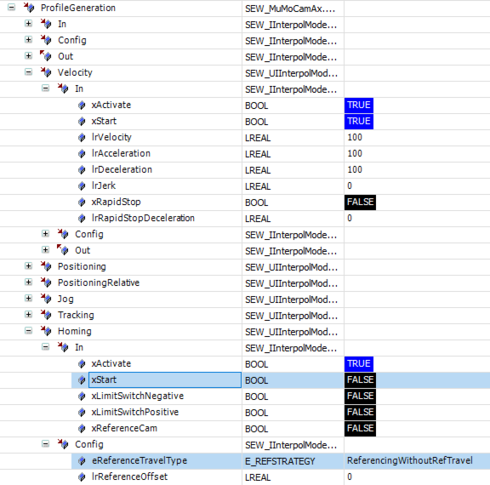Referencing on the fly
The following application example illustrates how you can perform referencing during ongoing operation. Referencing on the fly can be useful for endlessly turning axes without mechanical intervention, such as simple conveyor belts or rotary tables. In both cases it is useful to define a position zero point with reference to a product. The reference point could be the front edge of a product or a label on the product, for example.
Control
For example, control the axis in the Homing structure as follows:
Interface in the IEC Editor

Explanation:
The axis is enabled and moves at the specified speed in Velocity operating mode. The Homing operating mode is active and the required reference travel type and reference offset have been set (in this example: 0). With the respective event, such as the front edge of a product in a light barrier, xStart is set in the Homing operating mode.
The following trace recording shows this behavior: With the rising edge at xStart, the current position value is deducted from the position offset. The setpoint position of profile generation jumps to the value 0 without a change in the speed and acceleration profile. The position of profile generation now indicates the distance of the front edge of the product and the light barrier.
Trace recording

[1] | SEW_GVL.Interface_Axis1.ProfileGeneration.Homing.In.xStart |
[2] | SEW_GVL_Internal.Axis1._fbProfileGenerationControl._stOUTInterpolation. stSetpointsUserUnits.lrPosition |
[3] | SEW_GVL_Internal.Axis1._fbProfileGenerationControl._stOUTInterpolation. stSetpointsUserUnits.lrVelocity |
[4] | SEW_GVL_Internal.Axis1._fbProfileGenerationControl._stOUTInterpolation. stSetpointsUserUnits.lrAcceleration |
[5] | SEW_GVL_Internal.Axis2._fbProfileGenerationControl._stOUTInterpolation. lrActualMotionPositionUserUnit |
[6] | SEW_GVL_Internal.Axis2._fbProfileGenerationControl._stOUTInterpolation. lrActualMotionOffsetUserUnit |
